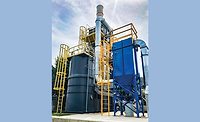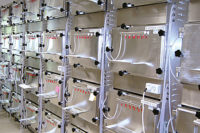Controlling VOC Emissions




In lieu of creating a National Industrial Adhesives rule, the U.S. Environmental Protection Agency (EPA) adopted in 2008 the Industrial Adhesives and Sealants regulation as a Control Technology Guideline (CTG). The regulation empowers states to adopt their own regulations, especially in ozone non-attainment areas. Such regulations could have a huge impact on how rubber-to-substrate adhesive users conduct their business—today and in the future.
A recent change involves the creation of a new Ozone Non-Attainment Area (3745-21-28) VOC Rule for Cleveland, Ohio. This new regulation is based on and is
| Click here to jump to: |
consistent with the EPA’s CTGs for Miscellaneous Industrial Adhesive Application Operations. The control requirements regulating miscellaneous industrial adhesive application operations in the former Cleveland-Akron-Lorain eight-hour ozone non-attainment area will apply to businesses if the combined VOC emissions from all sources are equal to or exceed 3.0 tons per 12-month rolling period.
If impacted, adhesive application operations must comply with either the specific VOC content limitations, depending on the application or the substrate being bonded (e.g., 0.3 lbs VOC per gal of adhesive for bonding metal), or install an emissions control system that reduces VOC emissions by at least 85%. Specific adhesive application methods (e.g., electrostatic spray) and work practices may also be required to meet the new regulations. Additional recordkeeping requirements are also now mandated to ensure applicability and compliance with the new regulations.
The new ruling may also drive changes in other ozone non-attainment areas in the U.S., as already experienced in Pennsylvania, New Jersey, and much of the Northeast and California. As these regulations are adopted in additional areas, adhesive applicators have several options to consider:
• Install incineration or abatement equipment
• Outsource adhesive application to a custom coater
• Use lower VOCs and HAP-compliant materials
• Use aqueous adhesives
• Exit the business
Selecting the right solution requires a careful review of specific objectives and a close partnership with key suppliers.
UNDERSTANDING THE REGULATIONS AND BUSINESS REQUIREMENTS
The first step in determining the best option for your organization is to gather the appropriate suppliers at the table. It is wise to invite technical and account management professionals from adhesive and equipment suppliers to attend a joint meeting to begin the evaluation. Having all of the players together at the same time ensures collaboration and the development of a solution that meets specific process, product performance, and business requirements.
For example, when LORD Corp. faced this scenario at its Bowling Green, KY, plant, it brought together the experts in process, productivity and product know-how. In this case, all options were considered and the final decision was to install an aqueous adhesive application line to meet the business needs. The evaluation process should entail a review of three key areas: regulatory guidelines, business objectives and suppliers.
Regulatory Guidelines
Companies should start their research with a thorough review of the new regulatory guidelines. It is important to have a clear understanding of the impact of the
Companies should start their research with a thorough review of the new regulatory guidelines. It is important to have a clear understanding of the impact of the new operating parameters. |
new operating parameters. Regulatory conditions can be structured in a variety of ways, and VOC and/or HAPs limit(s) may be by the day, the week or even the year. It is critical to understand what the specific requirements are so a cost-effective and efficient solution can be determined.
EH&S professionals are often a good place to start when looking for answers to these questions. If additional support is needed, the adhesives supplier can be a resource, along with local environmental consultants.
Business Objectives
The expected impact should be modeled once the operating parameters are confirmed. When developing the model, it is necessary to account for both current and future business needs so new equipment can be sized to meet short- and long-term customer requirements. Equipment and adhesive suppliers can help with modeling the equipment needs to help confirm the specific requirements.
Suppliers
Assembling the right team also is very important. It is crucial that the equipment and adhesive suppliers understand the specific needs and are able to customize a solution that helps meet the business objectives. Partners should be invested in finding the optimal solution for your organization and not promoting the one product line they have.
EVALUATING OPTIONS
With a clear understanding of the regulatory landscape and the business objectives, as well as the right team assembled, the next step is to evaluate the various options.
Installation of Incineration or Abatement Equipment
The installation of emissions control equipment has proven to be a cost-effective solution for many in the automotive industry, as it allows them to continue using the same materials that have provided excellent performance for many years. The downside of abatement equipment, however, is the cost and maintenance of the equipment, as well as the energy it uses. Further, if additional regulatory changes occur, such as a potential carbon tax, this option would likely have to be revisited.
Use of a Custom Coater
Outsourcing the adhesive application to a third party is a solution that many organizations use today. Companies that don’t have the space for new equipment or smaller companies that can’t justify the equipment expenses find the custom coating option attractive. Benefits in adopting this option are that the same material can be used, quality stays the same and floor space is freed up for other manufacturing operations.
However, this option may impact logistical costs and can require longer planning cycles and extra inventory. In addition, outsourcing can result in a loss of control as you are dependent on another party, which can impact WIP, inventory levels and schedules.
Adopt Lower HAP-Compliant Materials
Although the use of these materials may require different processing parameters, it allows adhesive users to maintain control of their operations while avoiding the capital expense that comes with an abatement system. Potential downsides are that low-HAPs materials are typically more expensive than standard solvent-based materials and the operating window may vary.
This option is ideal for companies that have a high HAPs threshold. However, use of lower HAP-containing products may not address VOC issues, depending on the formulation of the lower-HAP solvent system.
Adopt Aqueous Adhesives
Many companies that have VOC restrictions and do not want to install incineration equipment have adopted aqueous adhesives. Aqueous adhesives are regarded as a good long-term solution because their performance is usually equal to or better than their solvent-based counterparts, and aqueous products are unlikely to be impacted by any future carbon tax plans. A key to success in adopting aqueous products is to work with a supplier that understands the aqueous application process and can collaborate to ensure a successful equipment installation and product launch.
Drawbacks to aqueous products are that new application equipment is generally required, or at least preferred, and the operational process and parameters will likely need to change.
NEXT STEPS
How should companies proceed? First, review the environmental regulations for the city, state and municipality where you operate your business. Identify when the regulations were last updated and whether any pending regulation(s) may impact your operations.
Next, review your company’s operating permits and confirm when they expire. You will want to ensure that you are in compliance with current regulations and also with any anticipated regulatory changes. If you expect changes, review and consider the options discussed here to determine what option is best for you and your business. Be sure to assemble a core team of adhesive, pretreatment and equipment suppliers you can trust to help you make decisions.
The evolving regulatory landscape is a challenge for almost everyone in the adhesives and sealants marketplace so it is important, and some might even say critical, for adhesive users to align their businesses with suppliers that can support both current and future needs. Seek out suppliers who will listen to your needs and can utilize a broad portfolio of product and service options to meet your specific regulatory requirements and business needs.
For more information, contact Karen Sy-Laughner at (919) 468-5908, ext. 6427, or karen_sy-laughner@lord.com; or Carl Lechner at (919) 468-5879, ext. 6360, or carl_lechner@lord.com.
Looking for a reprint of this article?
From high-res PDFs to custom plaques, order your copy today!






